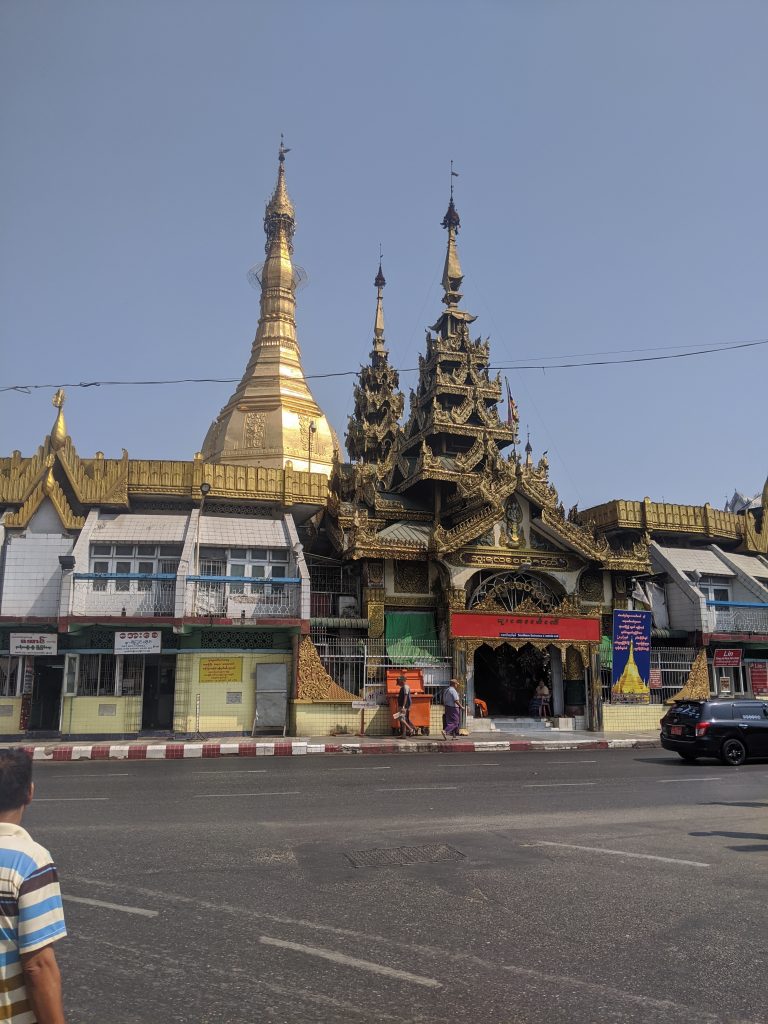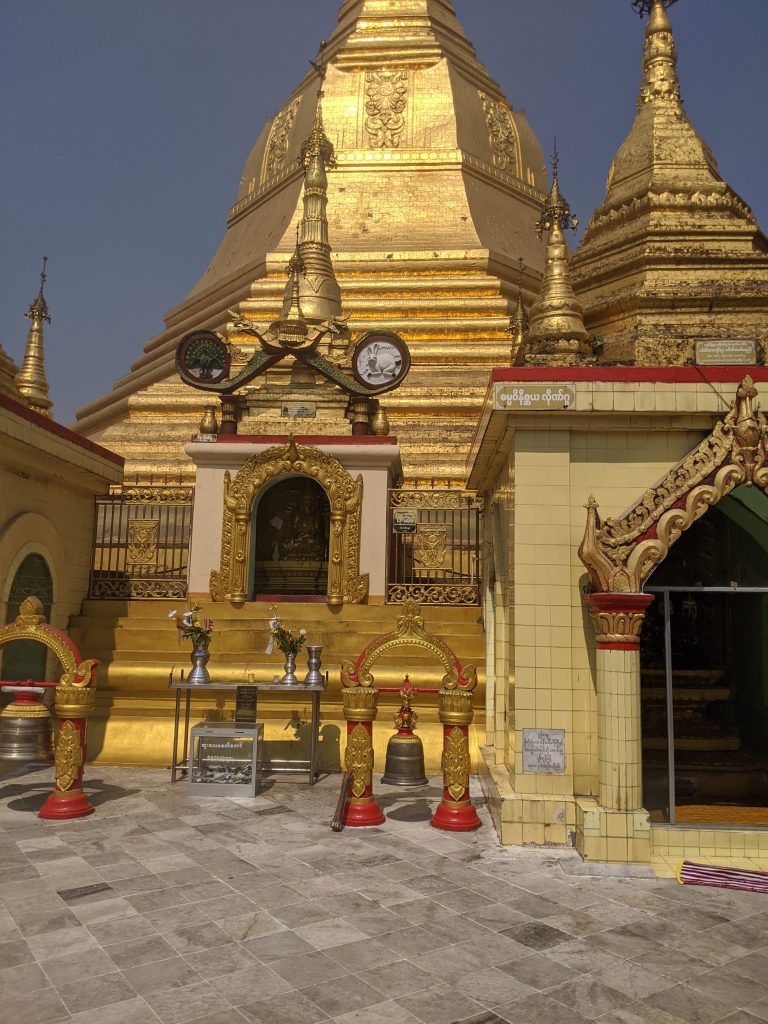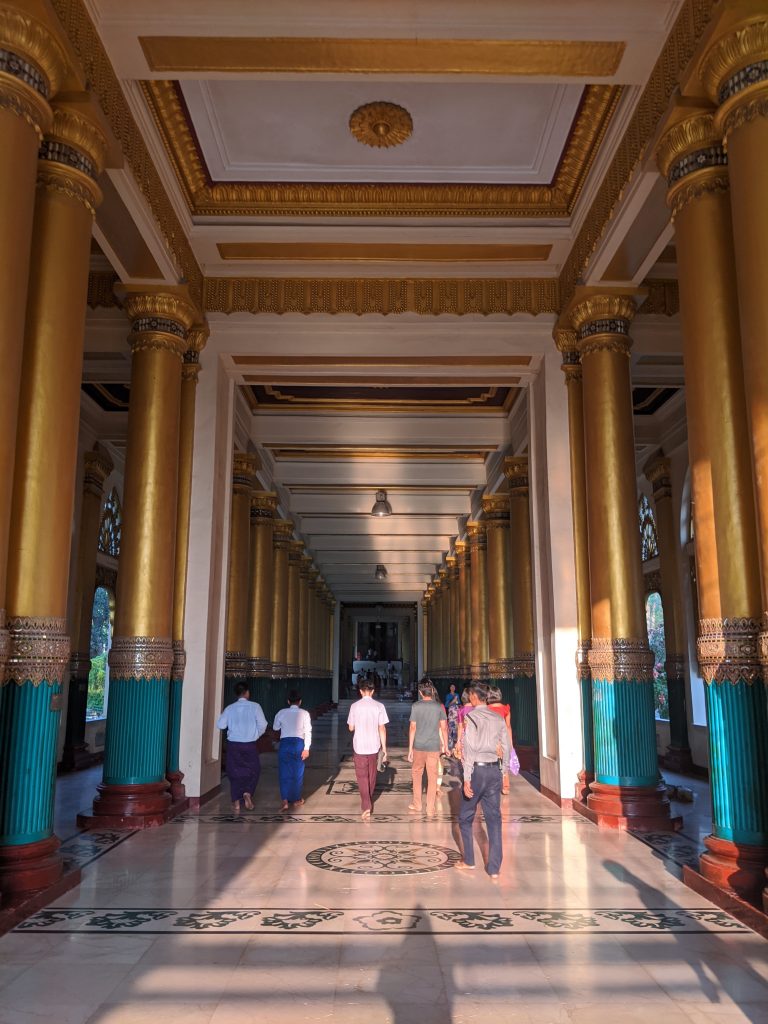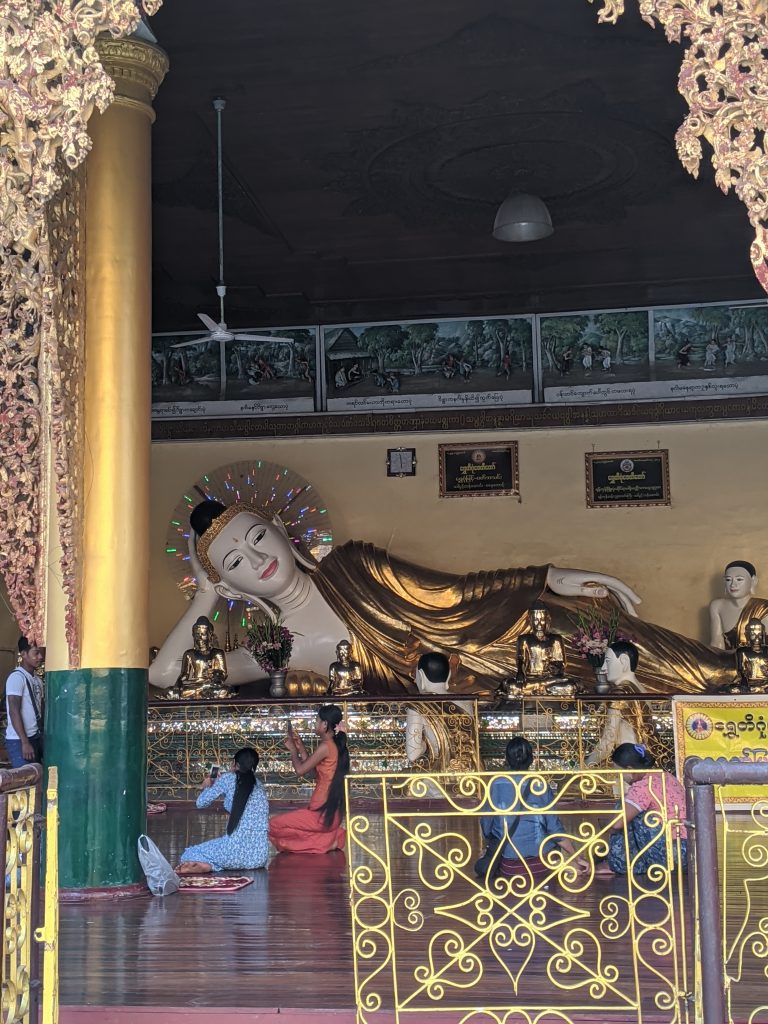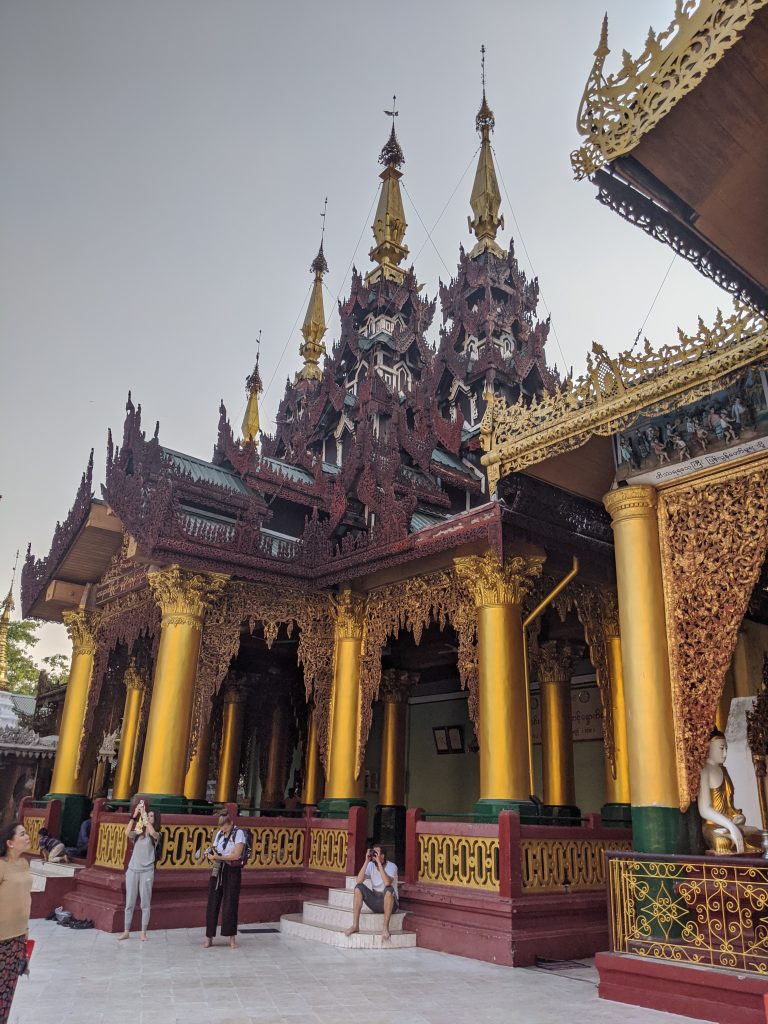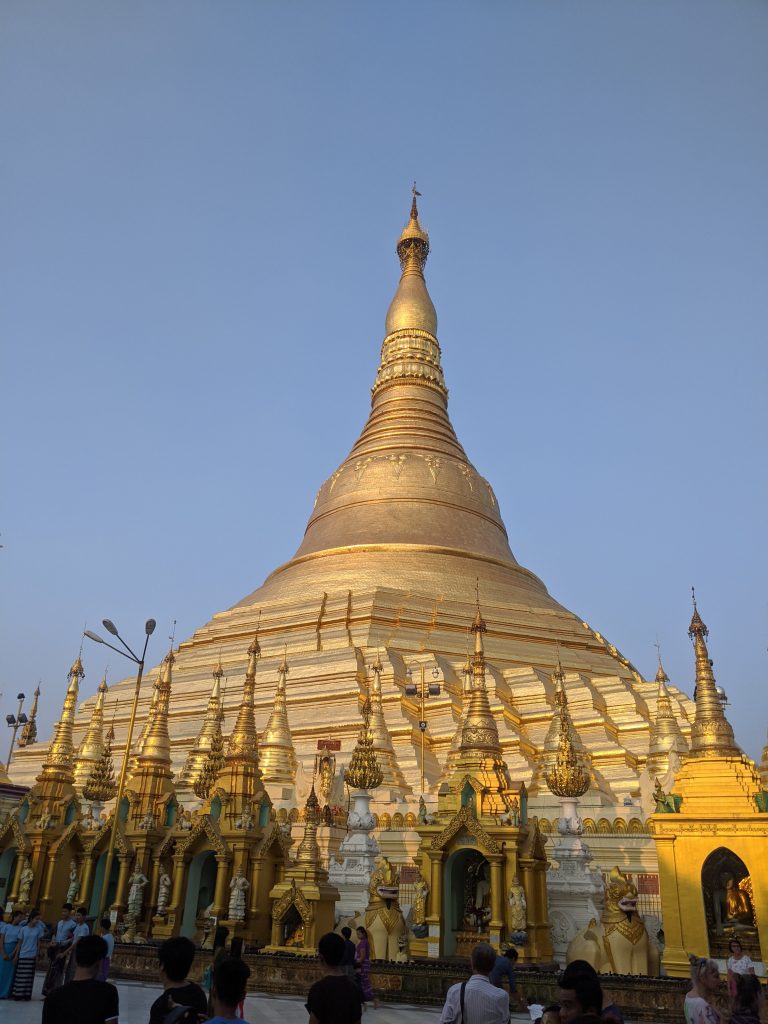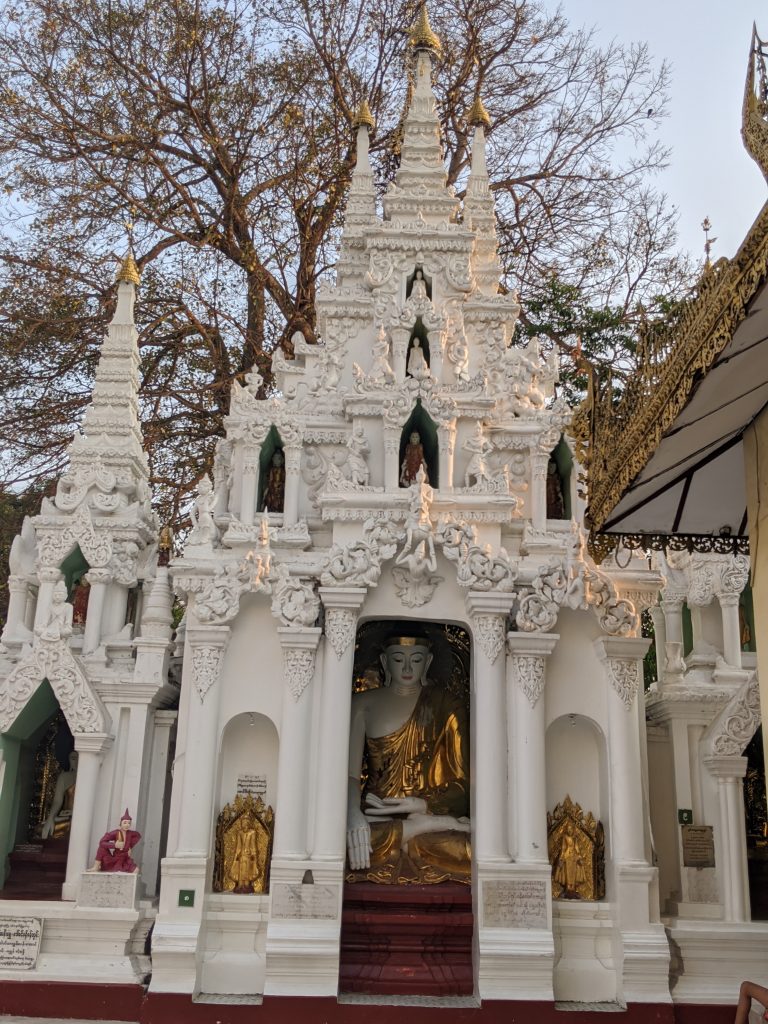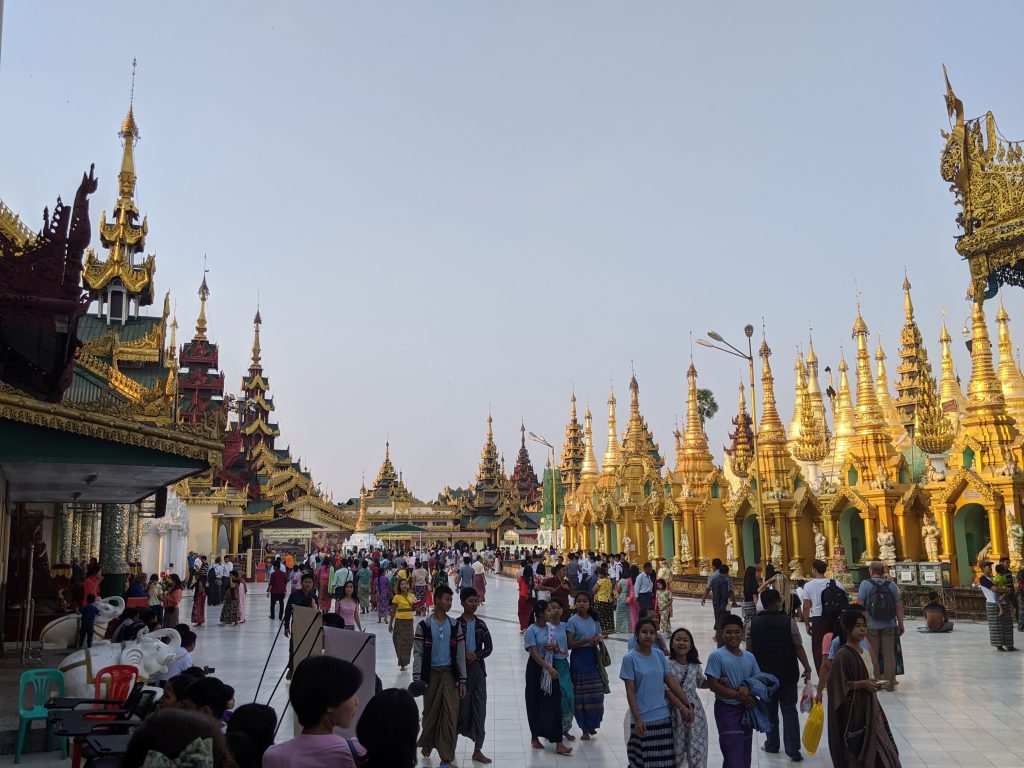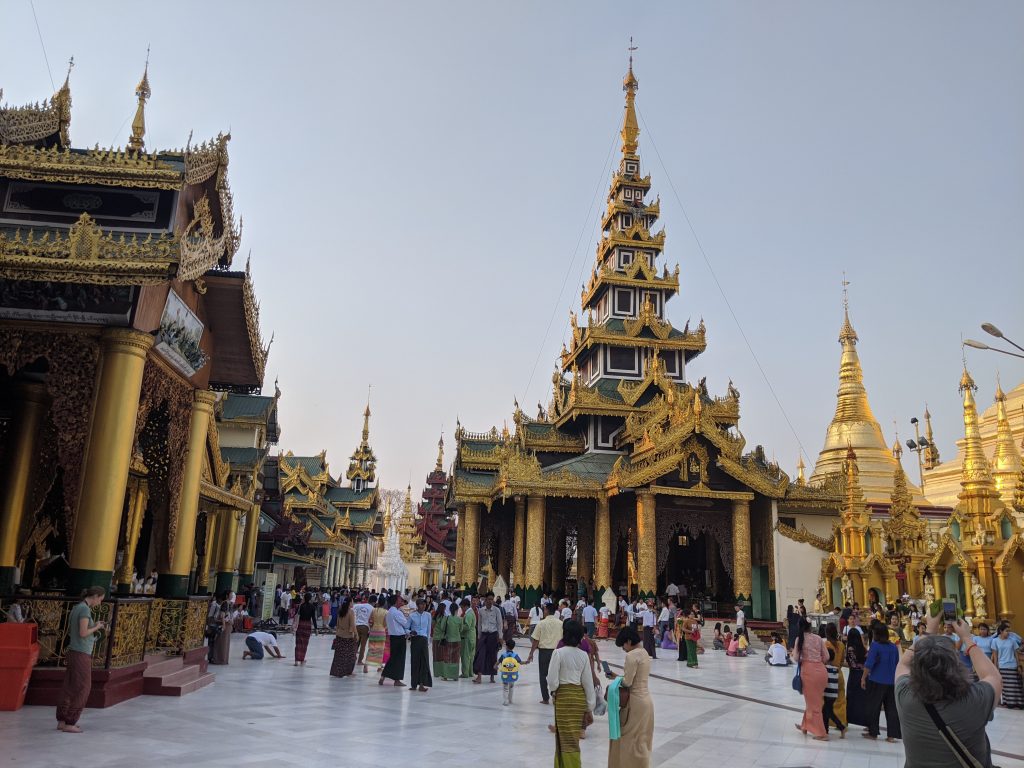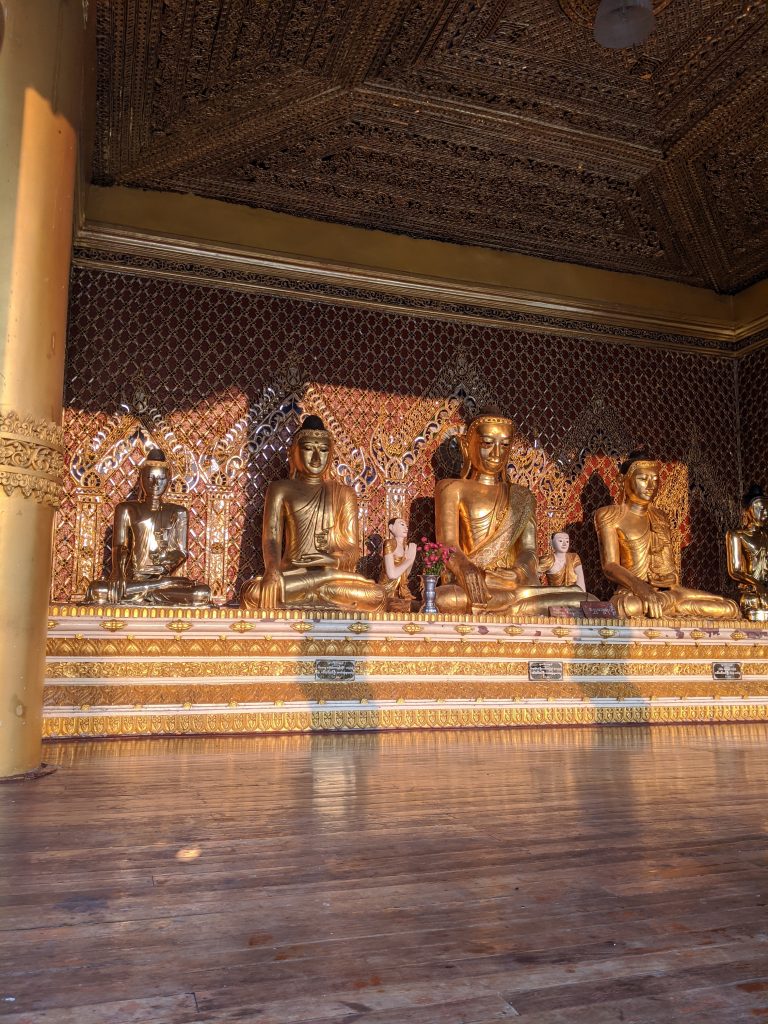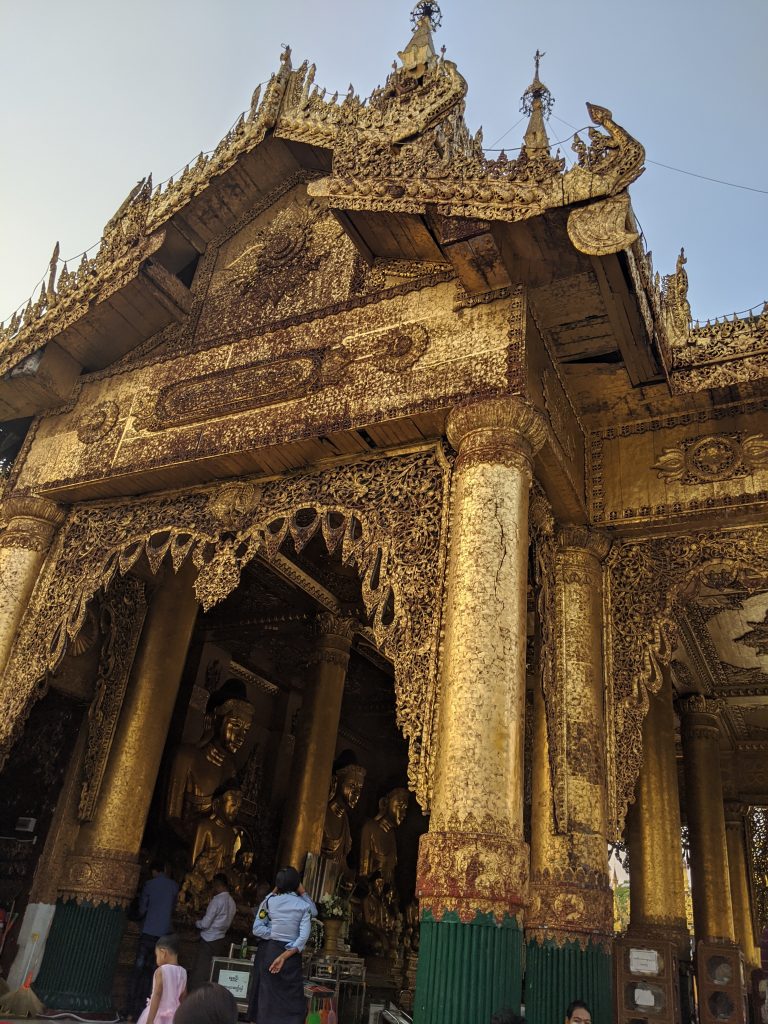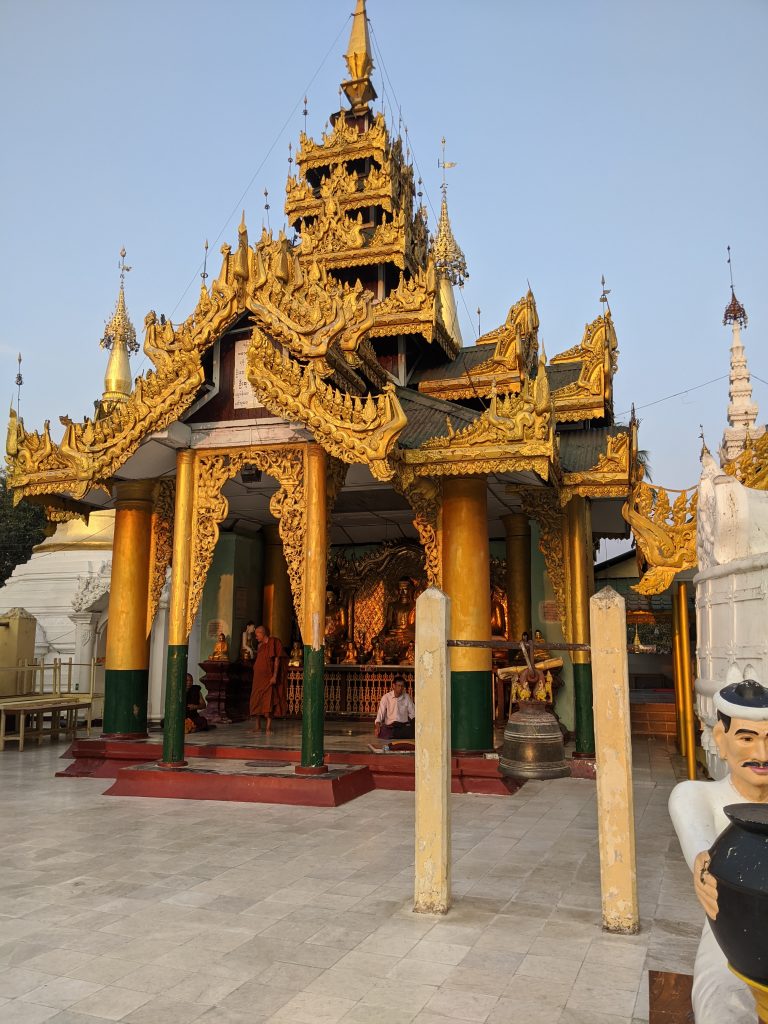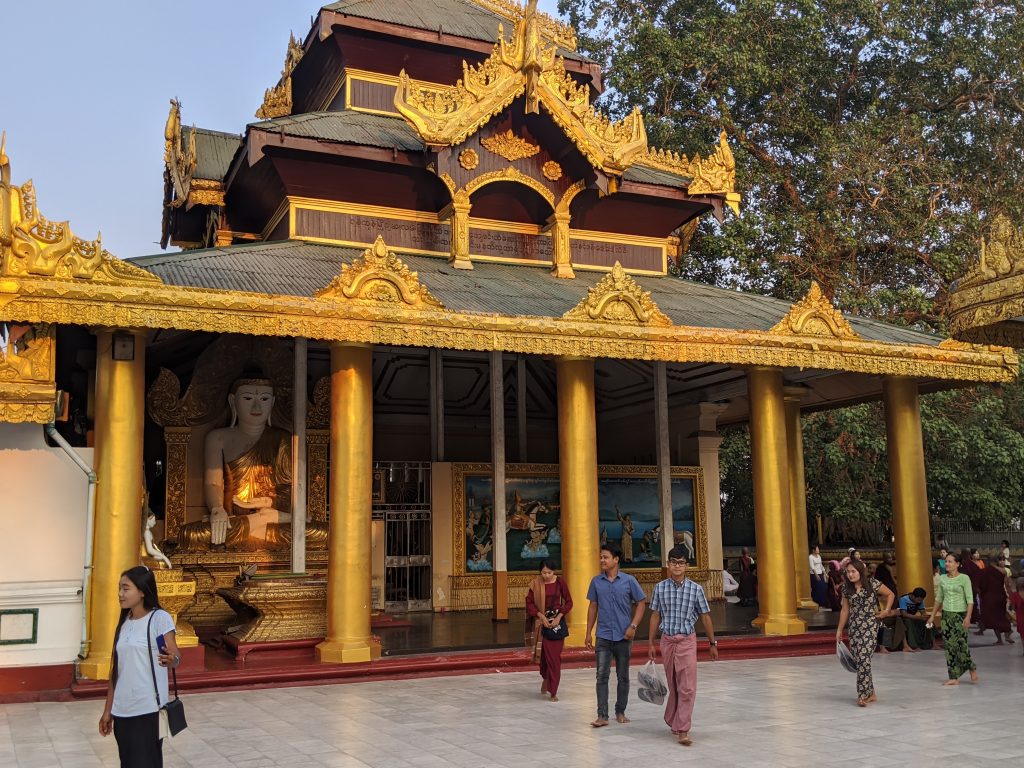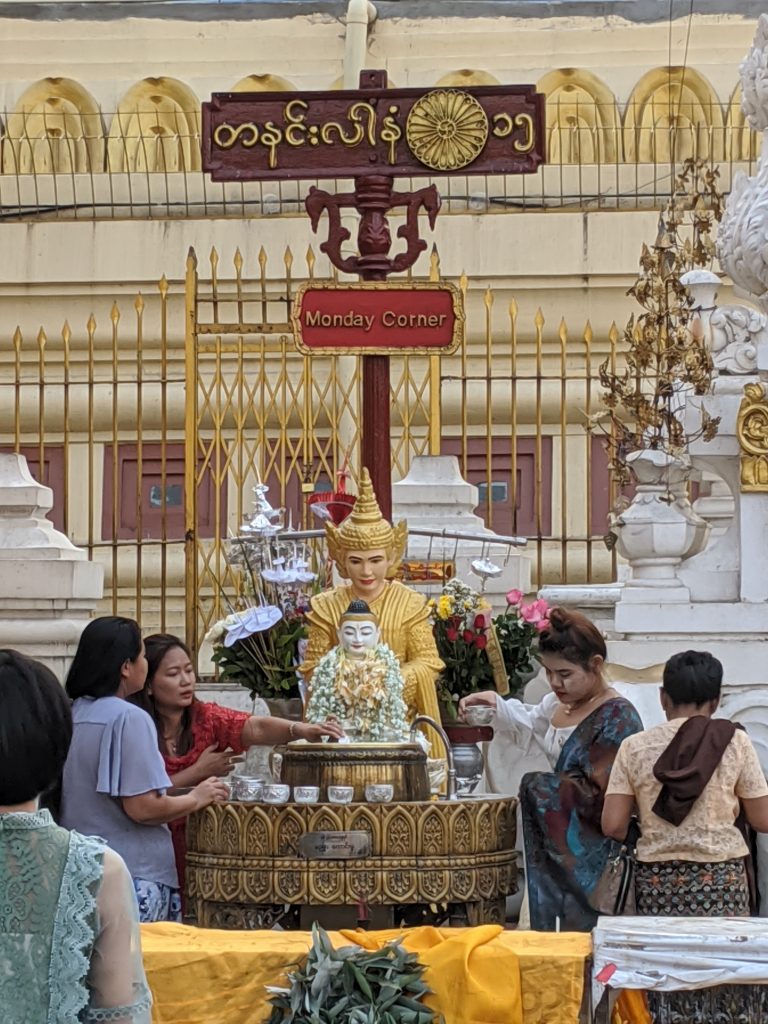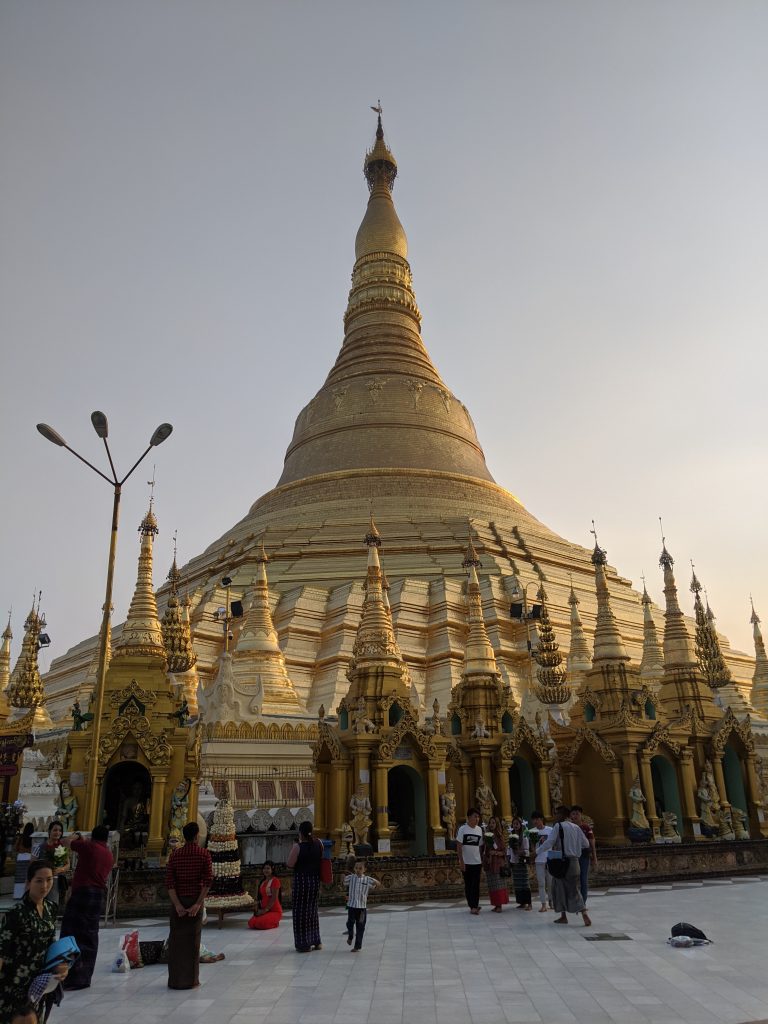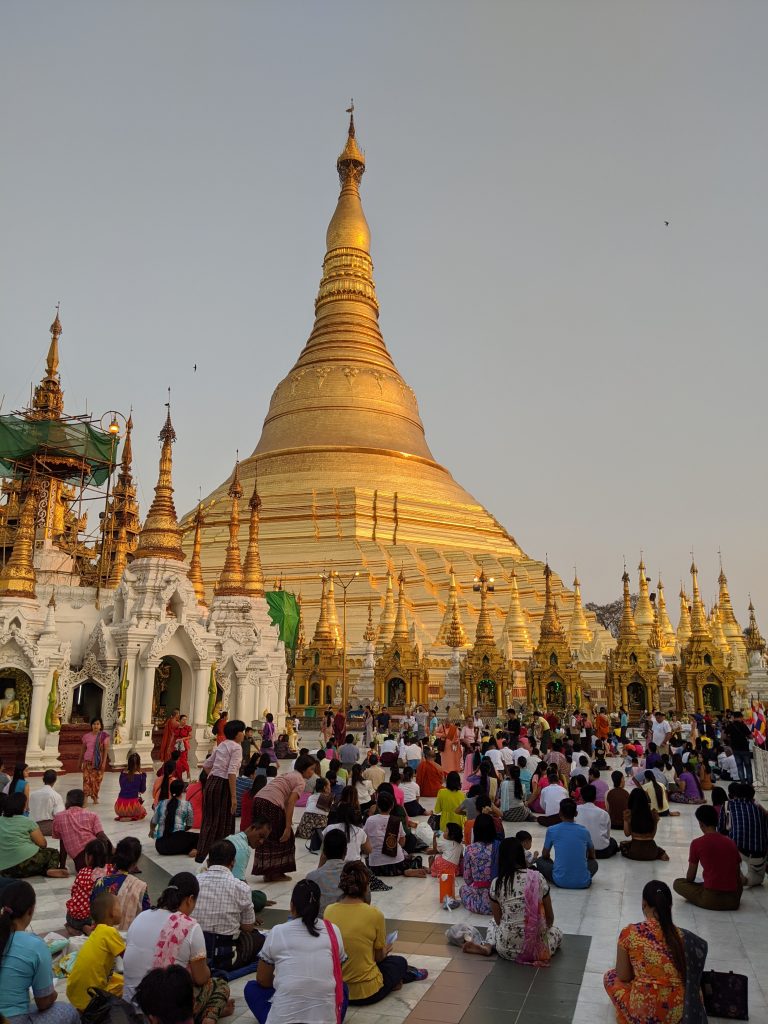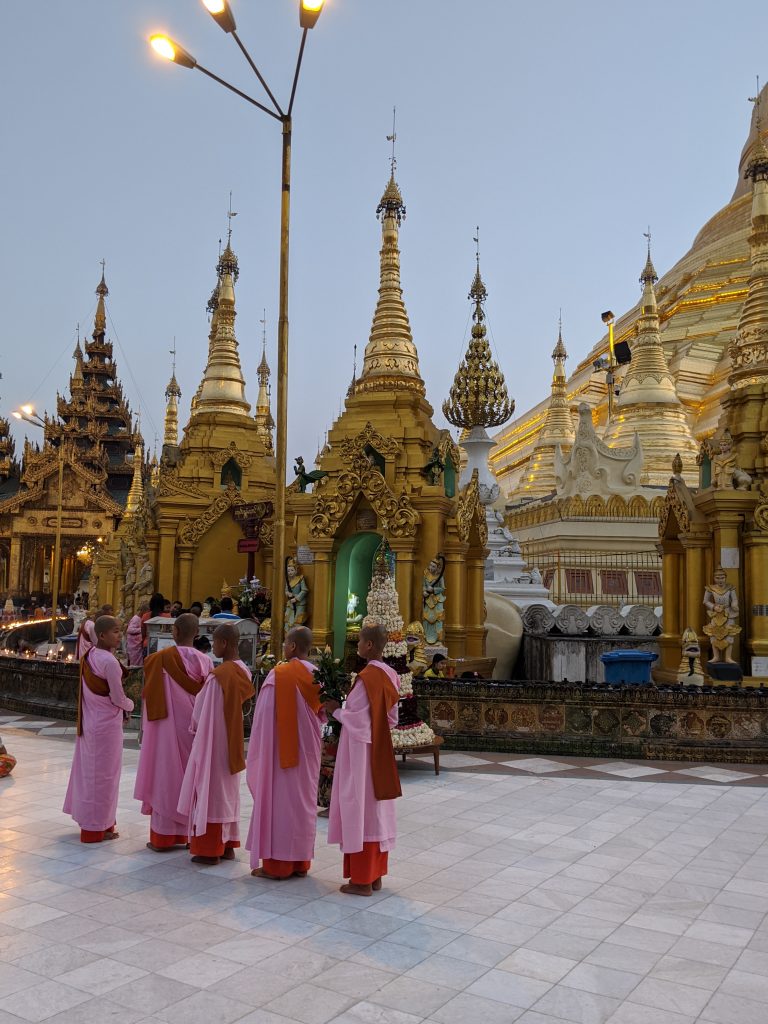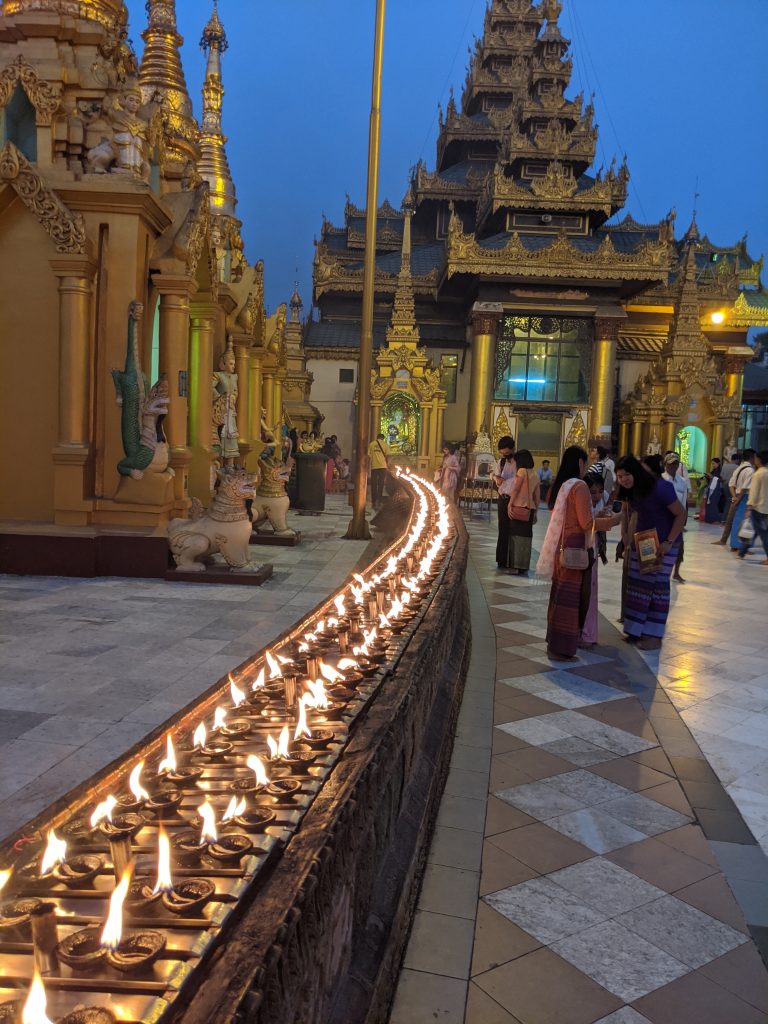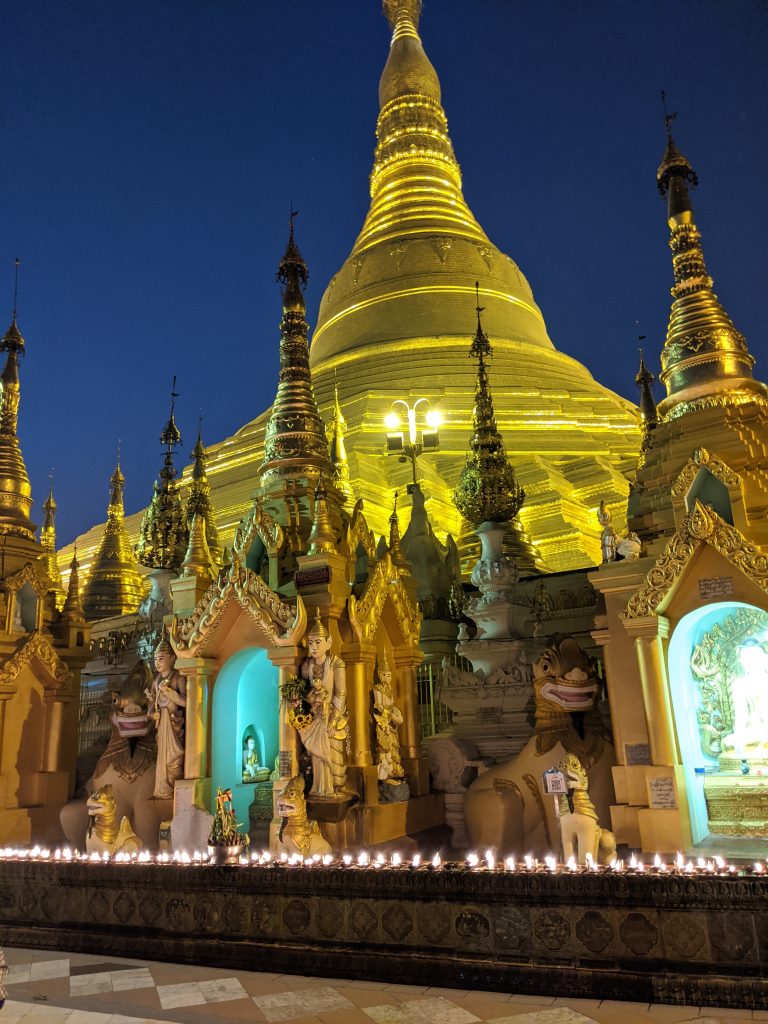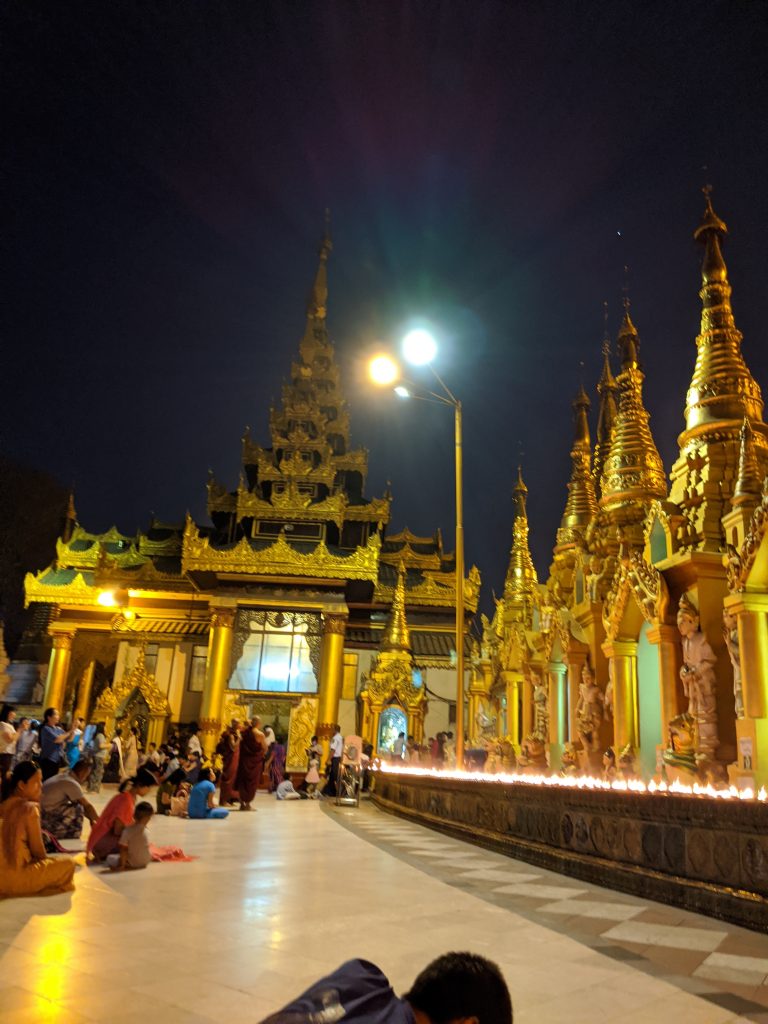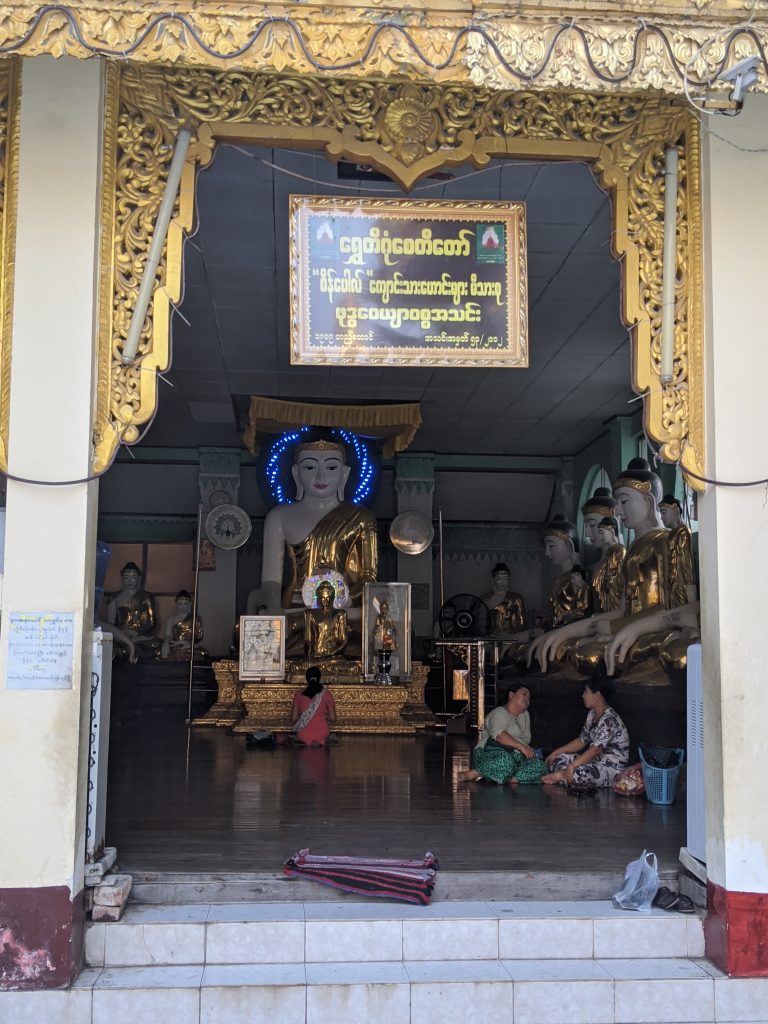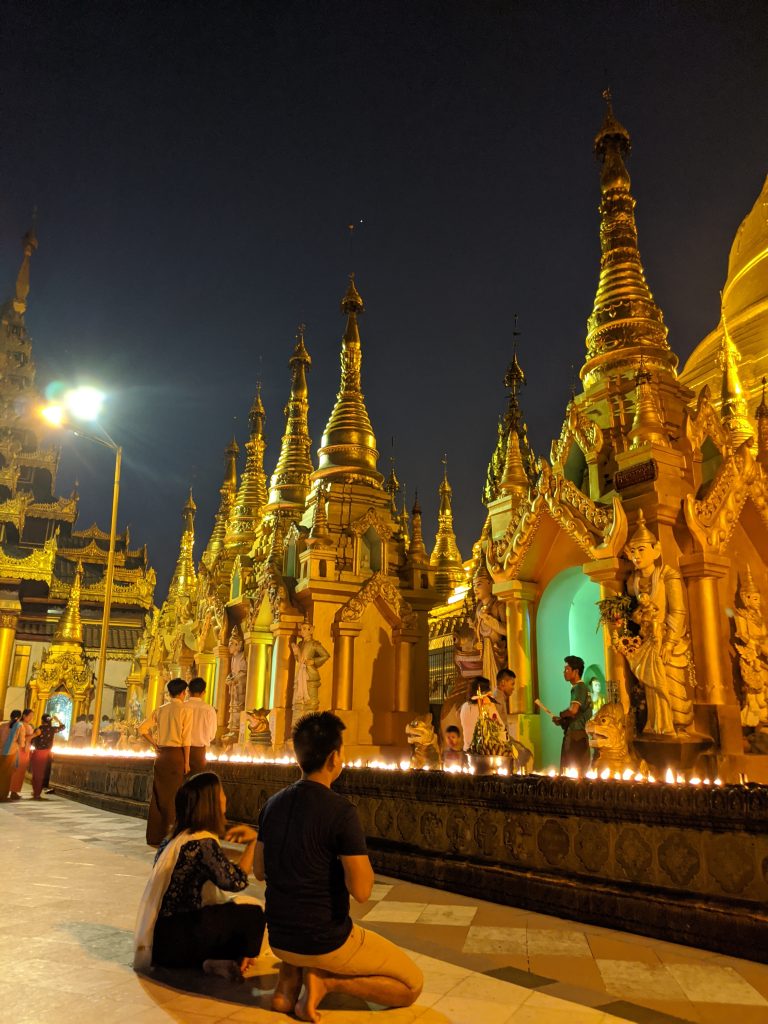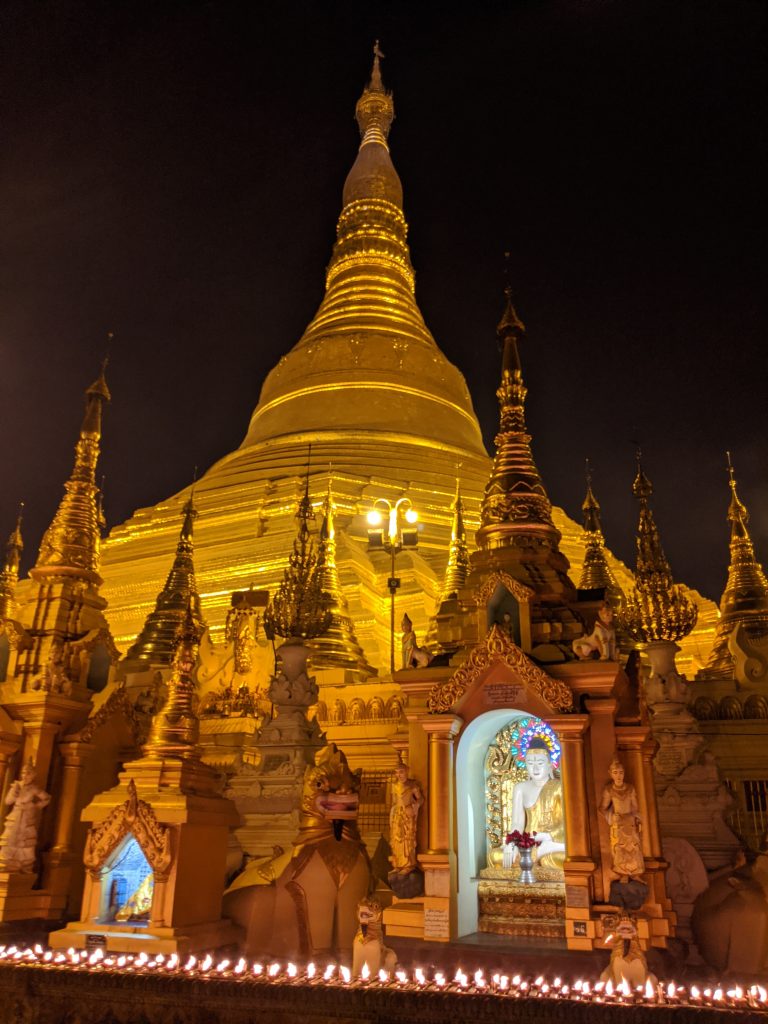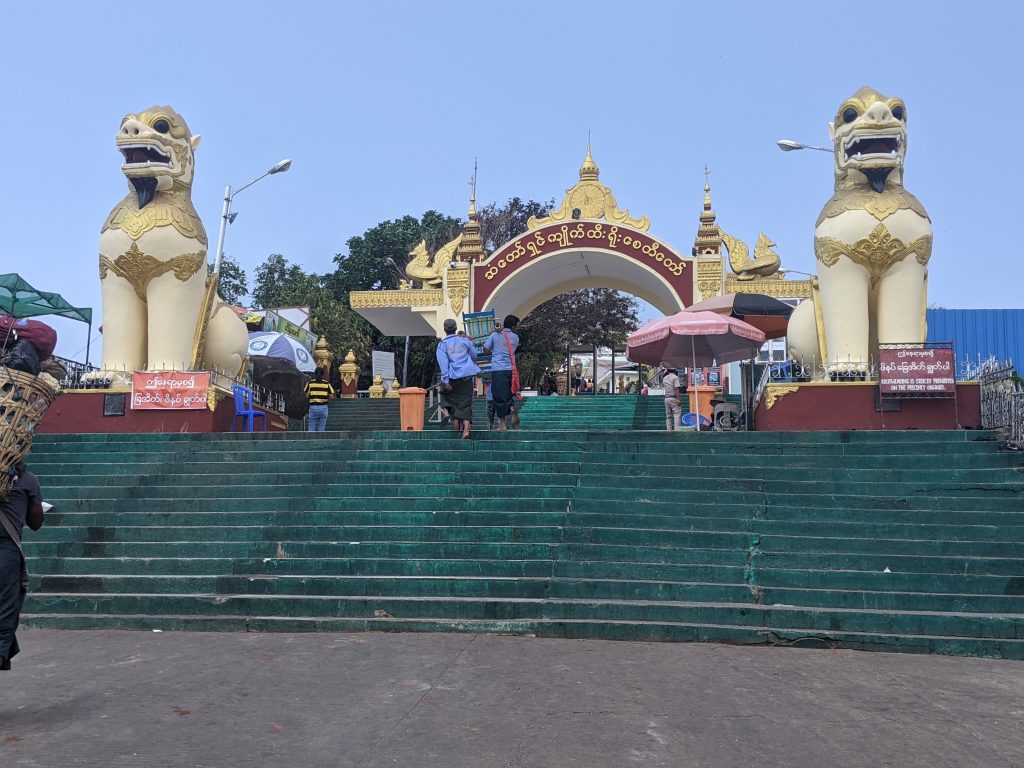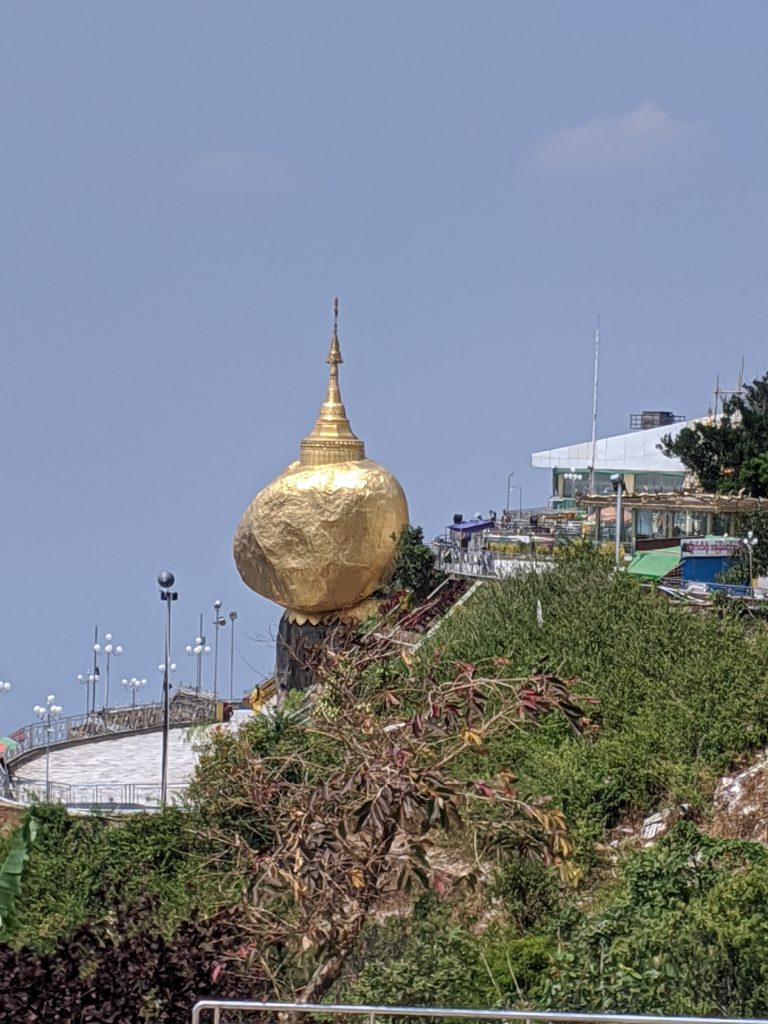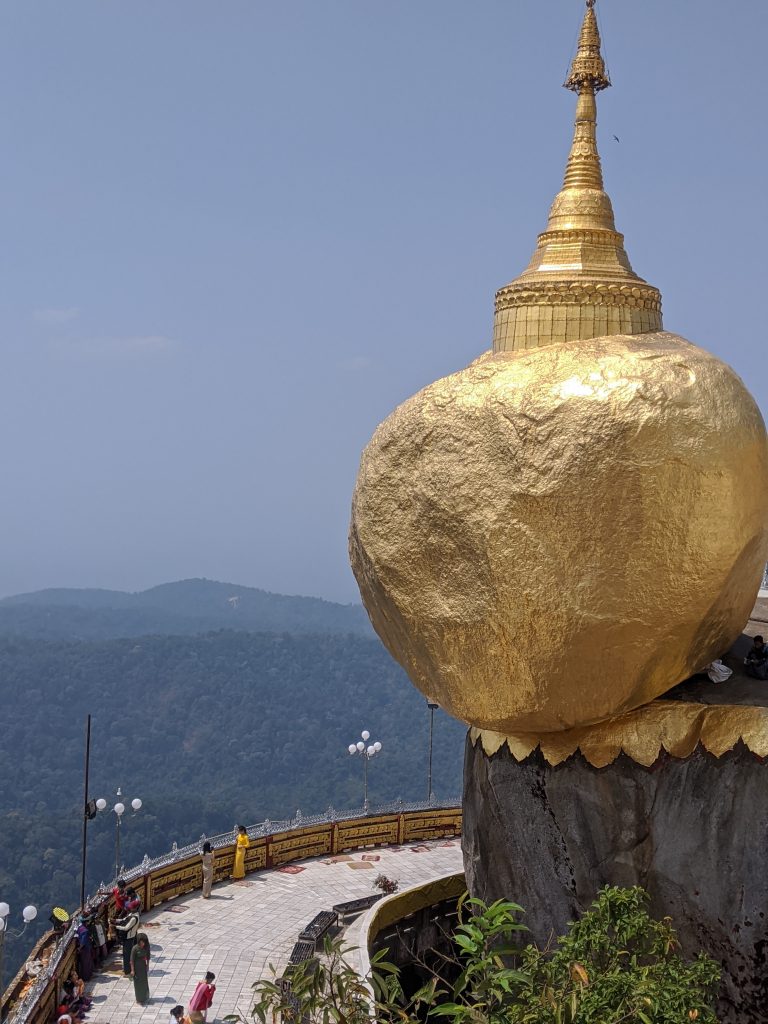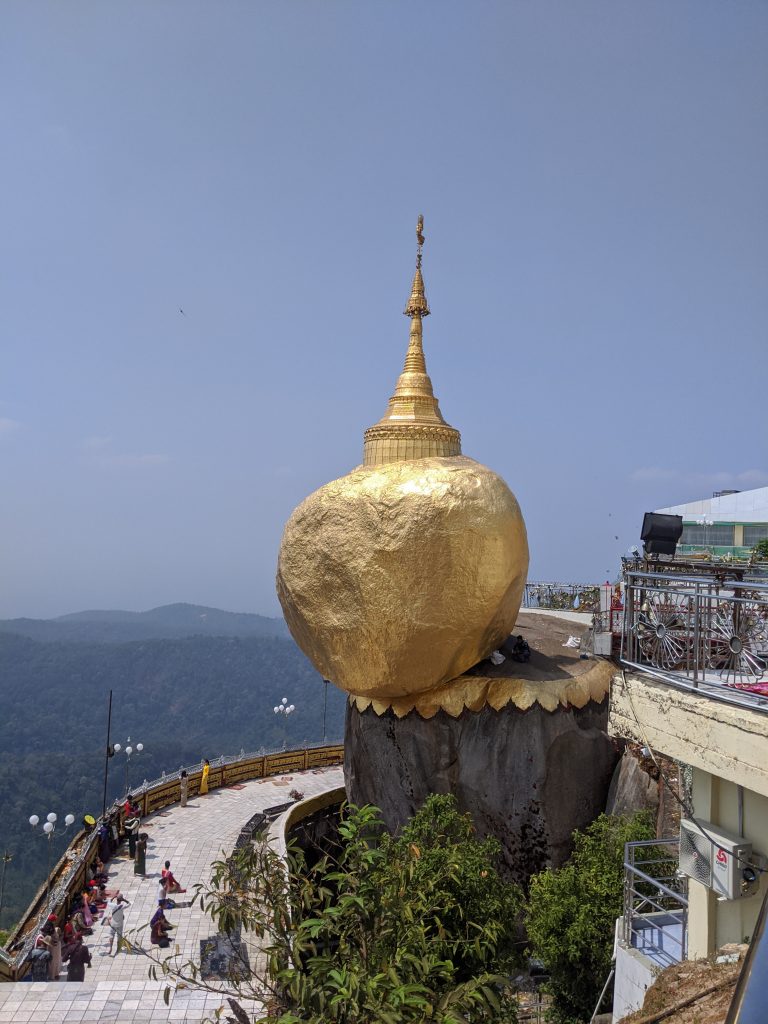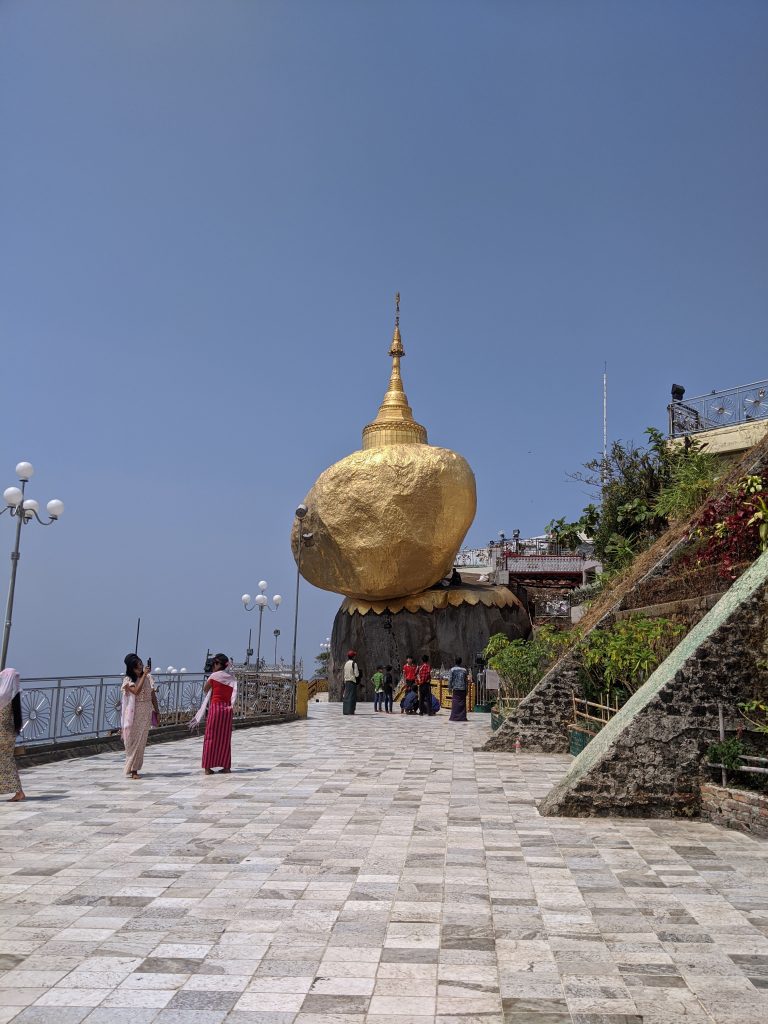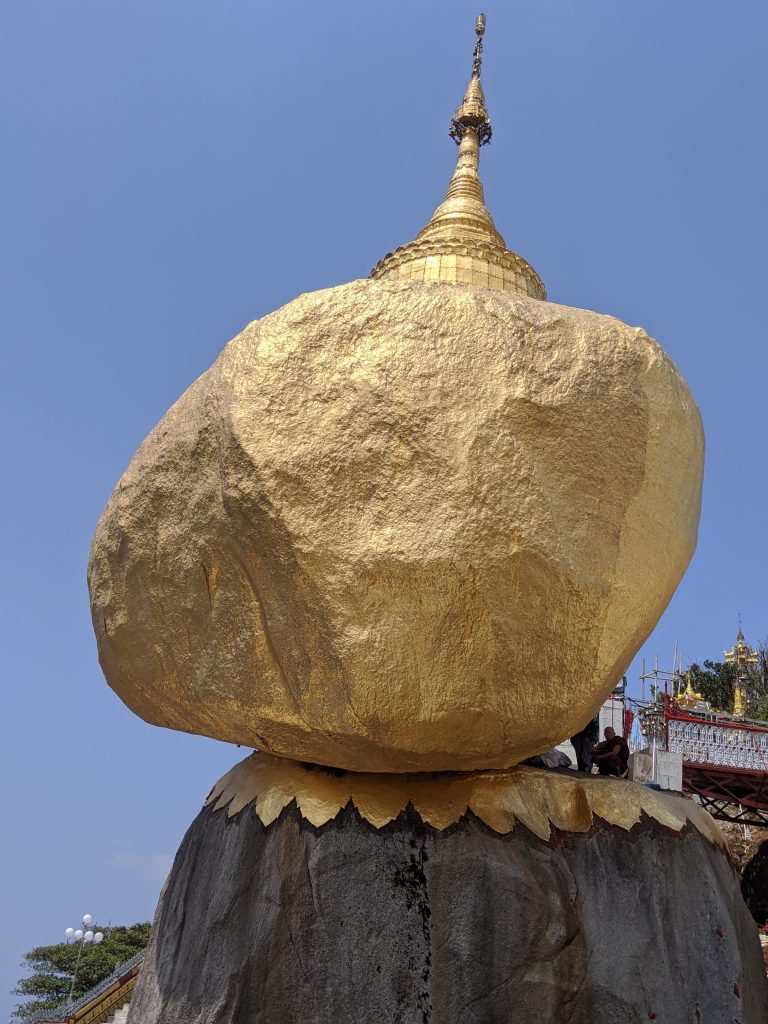My first day in Yangon, I woke up early to explore the city before the heat set in. Even at 7:30 am, the temperature was already in the nineties. The city is huge and the heat brutal, but I wouldn’t get a feel for the city from the inside of a cab. I decided to brave the heat, at last for the morning, on my two-mile walk to the Sule Pagoda.
The first thing I noticed about Yangon was the smell. Or rather, smells. On leaving my hostel, I walked through a market that was filled with scents of old chewing tobacco, rotting vegetables, and cigarette smoke, all exacerbated by the intense heat.
I left the market and walked behind a woman and her young daughter holding hands crossing the street. Halfway through, the woman stopped in the middle of the crosswalk, proceeded to vomit everywhere, and then continued walking across the street.
Myanmar was off to a rough start.
I’m going to stop here and say that, Myanmar was one of my favorite countries on this trip. Several travelers I encountered in other countries described Myanmar as ‘The Wild West of Asia’. It’s easy to can see why. While highways, cars, and wifi are far more plentiful than they were even ten years ago, much of the country feels untouched by tourism. I saw very few foreigners in my time here and I was getting to see a slice of Southeast Asia before tourism completely took over.
However, in other ways, this did not work in my favor. The only way to get around was by walking or taxi, Google Translate didn’t work here, the bus system was all but impossible to figure out if you don’t speak the language, and driving was, for lack of a better word, terrifying. Cars here are built with the driver’s seat on the right side, – like in the UK – but cars drive on the right side of the road – like in the US. I spent half of my time in Yangon sitting in traffic because of some sort of accident or another.
But the morning I begin my walk to the Sule Pagoda, I know none of these things. I know I’m nauseous from the smell and the heat and currently wondering if projectile vomiting is a symptom of coronavirus. I’m not nearly as worried about getting sunburnt as I am about overheating, as the temples here have very strict rules of what can and can’t be worn. Women must have their shoulders covered and a sarong covering their legs, so I’m sweating through layers.
The Sule Pagoda sits in the heart of downtown Yangon and is estimated to be around two thousand, six hundred years old. It is quite stunning to see the building sitting in the middle of the city.
When I entered the stupa, I was immediately bombarded by two women at the entrance shouting things at me in English, then shoving flowers and incense into my hands before demanding three thousand kyats (about two USD). I just put them on the ground and walked into the temple. They shouted angrily at me as I walked away. Laos had the most laid-back vendors or anywhere I visited. Yangon, on the other hand, had the most aggressive. However, coronavirus may have played a large role in this. While Myanmar doesn’t receive nearly the number of tourists as some of its neighbors, for these types of vendors, it still heavily relies on those making Buddhist pilgrimages. Many had been suffering in the last few months as a result of China and other surrounding countries closing borders.
I realized I had no idea where to go. There’s little English to be found in Yangon, and it was no different at this temple.
A young man walked up to me and said he was a student and wanted to show me around and practice his English. The first stop we made was a small ‘birthday’ fountain. There are seven – one for each day of the week – and you find the one that correlates with the day of the week you were born. He then directed me to pour a cup of water five times onto Buddha’s head and three times on the tiger’s head. I’ve tried to find out the significance of this. However, I couldn’t find anything about this online, I think there’s a good chance I misunderstood the directions, but here’s a photo of me doing it anyway.
After the fountain, the man shuffled me into a small room where a “monk” was performing blessings. He’d perform a blessing for you and your family using a candle, then give you a small bracelet as a token of protection. Then, he would demand ten thousand kyats (about six USD). To avoid further confrontation, I gave him the money and left.
Feeling miffed at the interaction, I told the ‘student’ I was going to spend the rest of the day on my own. I gave him a tip (which would have been more if the monk hadn’t requested so much) and went on my way. I found out later monks never request money for a service. I encountered fake monks all over Myanmar, an especially gross tourist trap.
I spent most of the day wandering around, trying food, and looking for water and shade. Once the sun began to set, it was time to head to the Shwedagon Pagoda, the crown jewel of Yangon.
Thankfully, there were only real monks in this temple and lots of locals and foreigners alike. This was the first place on my travels where I encountered what appeared to be women who were monks. They are called Thilashin, and they aren’t full-fledged monks, but instead are sort of to Buddhism what nuns are to Catholicism. Instead of the traditional orange robes, their robes are pink.
The pagoda is also believed to be around two thousand, six hundred years old, and it’s hard to describe how vast this pagoda is, filled with hundreds of temples, stupas, and statues. There is something very distinct about Buddhist temples in Myanmar compared to other countries in Asia. It’s the only place where flashing neon lights seem to be found in every holy place, giving the whole experience an anachronistic, cyberpunk feel. At night, the lights are given their chance to shine, and over one thousand candles are lit throughout the vast pagoda.
I had a pretty rough time in Yangon, but visiting this temple made the trip to the city worth it.
I spent my last day in the Yangon several hours outside of the city visiting Kyaiktiyo Pagoda, or the Golden Rock Pagoda. It is most notable for the giant gold rock that sits precariously on the side of a high cliff. According to legend, it is balanced on one of Buddha’s hairs, preventing it from falling.
When I asked my hostel to book me a bus ride to and from there, I was not aware of how far it was. About 3.5 hours by car, I thought it’d be a good day trip. Little did I know the bus ride would turn that into an 8-hour ride, and that was just to get to the pagoda.
I arrived at the bus station at six in the morning, before the sun had even begun to rise. No one spoke English, and the ticket from my hostel was in Burmese so I had no idea what it said. I was just sort of hoping I’d end up in the right place. After having my ticket shown to several different drivers each pointing me from one bus to the next, I found the bus I was meant to be on.
Even though it was one hundred degrees outside that day, the bus was absolutely freezing. I had nothing but my thin sarong as I assumed I would be too warm, not too cold.
I thought being chilly would be the most of my problems until the bus driver turned on the speakers, blasting what I can only imagine was chanting monks, similar to the ones I had heard over the loudspeaker in the Shwedagon Pagoda. I put in my headphones and turned them up all the way, but I might as well have not had them in at all – that’s how loud it was. I thought maybe it was to bless our journey or something, but it went on for hours.
Hours. Literal hours.
About halfway through the bus ride, the chanting monks were turned off and a Burmese soap opera was played on the small TV upfront, volume still at full blast, though it was an improvement.
We drove primarily through rural areas, and there weren’t any ‘bus stops’ per se. There was a young boy on the bus, around 8 or 9, whose job was to keep a lookout for people wanting to get on. We stopped at least 30 times, which is probably why the 3.5-hour journey took closer to 8 or 9 hours altogether.
We finally arrived at our destination and – surprise – time for another ride, this time up into the mountains. I left the bus and climbed into what was essentially the back of a pickup truck with benches each a foot apart. Considering I’m a foot taller than everyone else there, I did not fit very well in that seat. They squeezed 30 or 40 people into the back of this truck and then headed up the mountain in what felt like a Universal Studios ride whipping around tight corners as we all smashed into each other. My hands were white from gripping onto the handle and side of the truck so tightly.
It took about forty minutes to get up the mountain, whipping quickly around corners so everyone in the back is smashing into each other. We stopped once at a vendor and a man stood up and gave a ten-minute speech in Burmese.
I was thankful when we made it to the top. The pagoda was stunning, and the rock truly did look like any minute it could go tumbling down the mountain and into the jungle. The location of the pagoda is even more beautiful, and I wished I wasn’t so burnt out from the ride so I could enjoy it more.
To say I stuck out here would be an understatement. On top of the fact that I’m very tall, I saw only 3 other foreigners in this whole temple, and because it’s so off the beaten path, everyone was staring. Everyone. I felt pretty uncomfortable. On top of that, there is apparently a ‘foreigner tax’ which I paid and then was given a badge to wear around my neck for the rest of the day, which felt more like a dunce cap than a badge as I walked around the temple.
I spent about ninety minutes exploring the temple before I grabbed a snack and headed for the journey back down the mountain. I was so tired and exhausted that instead of being terrified, I actually found the ride incredibly fun. I was tempted to throw my arms up like I was on a roller coaster. Probably for the best I didn’t. I was on a whole new level of slap-happy.
On the way back, the bus stopped at a small restaurant. I tried to order food, pointing to the food sitting out at the buffet, but they shook their heads and responded with something I couldn’t understand. After several minutes of trying to order food, I just left and sat outside to wait for the bus.
A group of young women watching nearby must have surmised what happened. One of the women spoke a few words of English, and cut her sandwich in half, offering it to me. I thanked her but shook my head. This was consistent with my experience in Myanmar. I couldn’t communicate with anyone but most people went out of their way to be friendly and welcoming.
The ride home was a bit faster and had far fewer stops, clocking in at a more reasonable 6 hours. I was very hungry as I only brought a few sweet rolls with me and didn’t anticipate being gone so long—I left the hostel at five in the morning and didn’t return until midnight.
After a cold, loud ride home, I laid in my bed on the top floor of my hostel. I am grateful for my time in Yangon, but I hope that Bagan, my next stop, would prove to be less taxing. I closed my eyes and fell asleep almost instantly to the sound of rats scratching and fighting on the roof.
